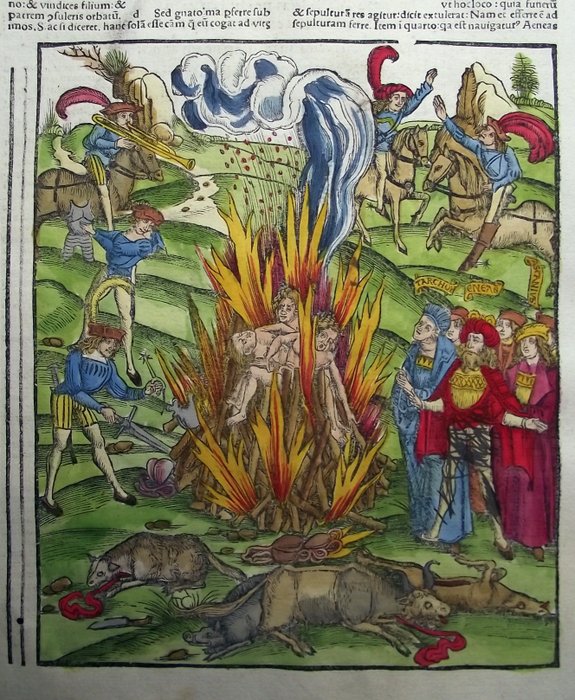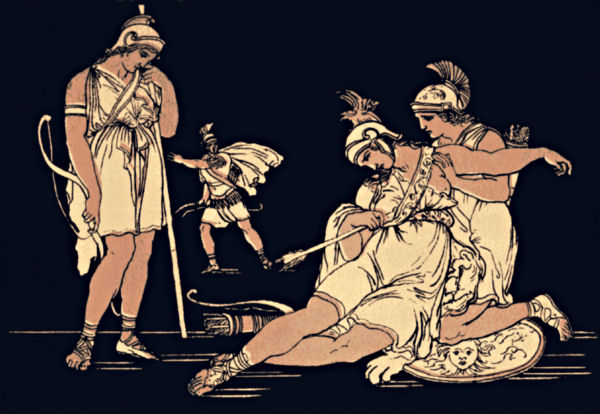The Aeneid, Book XI
Overview Book I Book II Book III Book IV Book V Book VI Book VII
Book VIII Book IX Book X Book XI Book XII
Truce & Death of Camilla
The next day Aeneas set up a tropaeum, a war trophy, by cutting the branches from a huge oak tree and placing Mezentius’ armour on it. He then encouraged his men for the next part of the war, saying they had nothing to fear. The Trojans then turned to the burial of the dead. Pallas’ body was being guarded by his father’s armour bearer, Acoetes, amidst great mourning. Aeneas felt great remorse and guilt that he could not return Pallas to Evander alive as he had promised. He arranged for Pallas’ body to be returned to his father on a wicker couch, dressed in two purple robes given to him by Dido, accompanied by enemy weapons and captives along with Pallas’ horse, Aethon.

The procession was escorted by one thousand men and mourners. Aeneas stayed in his camp to prepare for the next stage of the war. Latin envoys arrived to ask for a truce so that they could bury their dead. Aeneas agreed to a truce of twelve days saying this war should never have taken place; the quarrel should have been decided by only Aeneas and Turnus fighting. One of the envoys, Drances, who hated Turnus, praised Aeneas for his generosity and offered to help him build his new city.
Trojans and Latins side by side felled trees for the funeral pyres. Rumour of Pallas’ death came to Evander and the road into the city was lined with mourners holding torches. Evander regretted that he had outlived his son, hoped that he had killed many of the enemy before he died and that Aeneas would avenge his death by killing Turnus. Funeral pyres for the dead were built by the Trojans with armour and enemy plunder thrown into the flames and animal sacrifices offered to Pluto. The Latins returned their dead to their homes if they could and burnt the rest. The Latins whilst grieving blamed Turnus for the war and said he alone should be fighting.

Queen Amata however supported him as did his fame in war. King Latinus called a council meeting where a discussion took place as what they should do next: envoys spoke first saying that king Diomede had refused them help in the war: Diomede and the other Greeks who had fought at Troy had suffered enough in war; Aeneas was a formidable opponent; the Latins should make peace with him, not war. Latinus regretted not welcoming Aeneas previously and said that they should help the Trojans either to build their city nearby or build ships for them if they wished to settle elsewhere. In the meantime they should make a treaty with the Trojans. Drances criticised Turnus saying he was the cause of their suffering because he felt robbed of his royal bride; he should face Aeneas alone. Turnus angrily accused Drances and the Latins of cowardice; they had many other allies and they were inflicting just as many deaths on the Trojans; he would happily face a single combat challenge from Aeneas.

As they received word that Aeneas and the Trojans were lining up for battle, Turnus summoned the Latins to reinforce the city and prepare for battle while the women prayed to Athena to kill Aeneas. Turnus meanwhile planned to ambush Aeneas in a forest above a valley while the Amazon, Camilla, and other Amazons and Latins engaged their Etruscan cavalry in battle. Camilla had been dedicated to Diana by her father and, remaining chaste like the goddess, had been taught to throw the javelin and shoot arrows from childhood. But she was fated to die in this war. In the ensuing battle first one side and then the other had the upper hand. Camilla was killing many of the enemy until Tarchon roused the Trojans and their allies and Arruns, with the help of Apollo, killed Camilla while she was pursuing another warrior and off her guard. Opis, a nymph of Diana, avenged Camilla’s death by killing Arruns with an arrow.

Camilla’s cavalry and the Rutilians retreated to Latium after her death with the Trojans in pursuit. Many Latins were killed. When Turnus heard, he abandoned his ambush and came close to Aeneas’ forces. No battle was fought however as night fell and they both made camp in front of the city.
